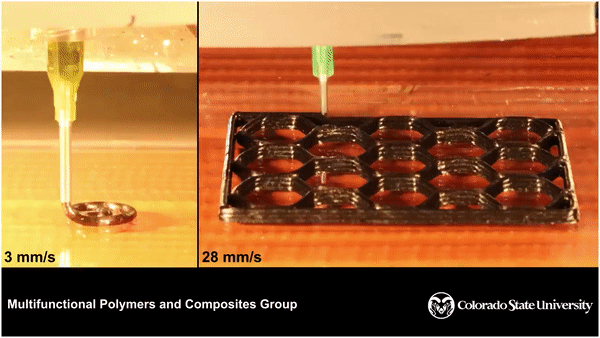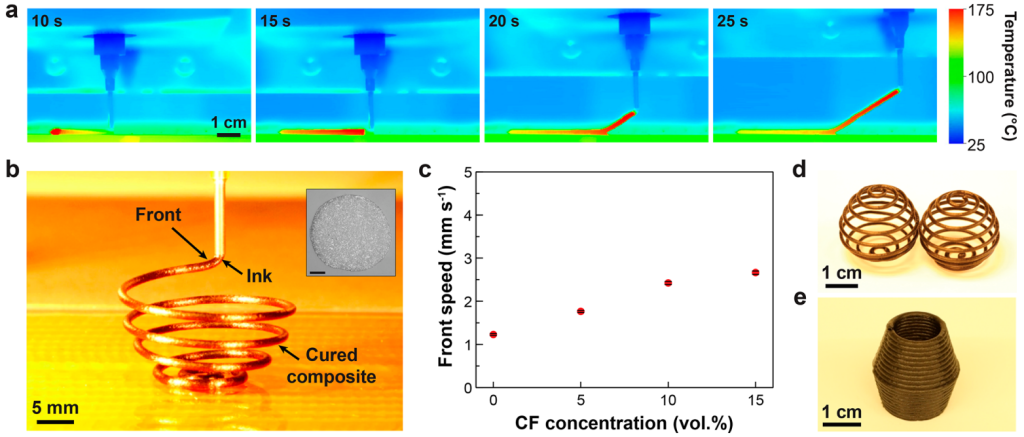Researchers from Colorado State University have developed a new method of 3D printing carbon fiber-reinforced composite parts without the need for support structures.
The technique relies on a specially-developed thermoset resin and a unique curing process called frontal polymerization, whereby the printing material cures as it’s being extruded. As a result, the part is printed and becomes rigid almost immediately without any external UV or IR radiation, allowing it to preserve its original freeform geometry free from supports.
As a bonus, the 3D printed composite structures also boast zero void content and the carbon fiber reinforcements are highly oriented for excellent mechanical performance.

Thermoset resins for composite 3D printing
Those looking to 3D print composite parts have a few options at their disposal. The most widely-used approach is FFF, which can be used to process both short chopped fiber materials and long continuous fiber materials.
While composite filaments are the most accessible and easiest to use, the resulting parts often aren’t always suitable for high-performance structural applications due to low service temperatures, poor inter-layer mechanical performance, large void contents, and relatively low fiber volumes.
According to the Colorado team, a potential alternative can be found in fiber-filled thermoset composite resins. These low-viscosity, heat-sensitive materials can be extruded via direct ink writing and often offer superior thermo-mechanical properties to their FFF filament counterparts. Unfortunately, thermoset materials have historically been plagued by severe processing issues related to their curing rates.
You could cure a 3D printed thermoset resin using UV or visible light, but photocurable variants don’t have a high enough curing rate to maintain the original printed geometry – they sag before they can harden and require supports. They also can’t be integrated with opaque or high-fiber-fill inks.
On the other hand, you could try a thermal curing mechanism but this would require very high ambient temperature conditions such as the inside of an oven. Ultimately, none of these approaches have proven successful in the past when it comes to 3D printing supportless freeform geometries.

Frontal polymerization to the rescue
The frontal polymerization curing strategy addresses the issue of low cure rates, but how does it work? In the present study, the Colorado researchers created their own DCPD-based (Dicyclopentadiene) thermoset resin filled with short carbon fibers.
Once printed, the curing of the resin is initiated locally using a thermal stimulus: the heated print bed. This then kickstarts a self-sustaining exothermic reaction that fires up the printing path, much like a lit fuse on a stick of dynamite. As a result, the composite resin cures in-situ as it’s being deposited.
By precisely matching the print speed with the front velocity (the speed at which the exothermic reaction travels), it’s possible to 3D print completely unsupported freeform structures that harden immediately.
As well as greatly improving mechanical performance, the addition of the carbon fibers was found to enhance both the rheological behavior and thermal conductivity of the composite resin. The researchers believe their frontal polymerization 3D printing technique can eventually be applied to a wide variety of reinforcement fiber types and even particle additives.
Further details of the study can be found in the paper titled ‘3D Printing of Short-Carbon-Fiber-Reinforced Thermoset Polymer Composites via Frontal Polymerization’.

Much like academia, industry is also home to several composite 3D printing innovations. Earlier this year, Swiss 3D printing specialist 9T Labs raised $17 million in Series A funding to fully commercialize its Red Series Additive Fusion Solution platform. A combination of 3D printing and compression molding, the platform is designed for the production of advanced carbon fiber-reinforced thermoplastic composite parts in volumes ranging from 100 to over 100,000 parts per year.
Elsewhere, Israeli 3D printer manufacturer Massivit 3D recently launched a new machine that’s specifically designed to reduce the time it takes to produce large-format composite molds. The Massivit 10000 is powered by the firm’s new Cast-In-Motion (CIM) technology and creates intricate tooling in a rapid four-step gel dispensing and casting process.
Subscribe to the 3D Printing Industry newsletter for the latest news in additive manufacturing. You can also stay connected by following us on Twitter, liking us on Facebook, and tuning into the 3D Printing Industry YouTube Channel.
Looking for a career in additive manufacturing? Visit 3D Printing Jobs for a selection of roles in the industry.
Featured image shows freeform and supported 3D printed parts. Image via Colorado State University.



